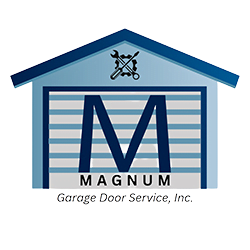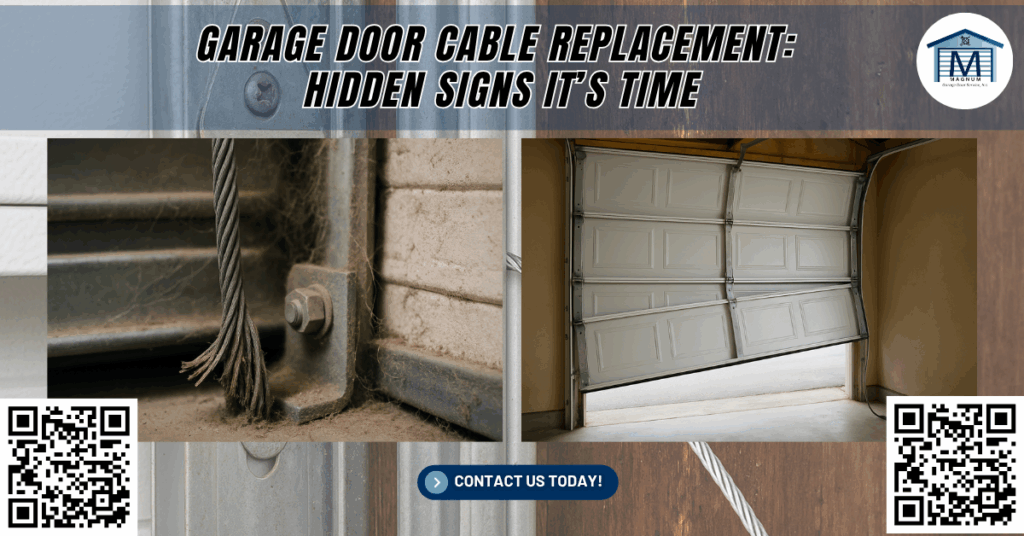A few weeks ago, in Aldine, TX, we received an urgent call from a homeowner whose garage door had become stuck midway while closing. One side of the door sagged at a dangerous angle. Her garage door system had essentially failed, and she was worried it might collapse. When our technician arrived, the problem became clear: a frayed garage door cable had finally snapped. The remaining cable was barely holding up the door, putting the entire system and her family at risk.
Unfortunately, this isn’t uncommon. According to the U.S. Consumer Product Safety Commission, over 20,000 garage door-related injuries occur annually, many of them preventable. Garage door cables are crucial to the safe operation of your door system, yet they’re often neglected during regular maintenance.
The key to avoiding accidents and costly repairs is recognizing hidden signs of cable wear before failure strikes. In this comprehensive guide, we’ll explain everything you need to know about garage door cable replacement, including how your system works, warning signs of trouble, and what to do when it’s time for replacement.
How Garage Door Cables Work
Garage door cables are part of a high-tension system that helps lift and lower your garage door smoothly and safely. They work in conjunction with torsion springs or extension springs, depending on your door’s design. When the door moves, the cables wrap or unwind around cable drums mounted at each end of the torsion tube, creating the proper spring tension needed for balanced movement.
Each garage door has two main cables, one on either side, connected to the bottom brackets at the lower edge of the door. These steel cables help carry the weight of the door, which can range from 100 to 400 pounds or more. Without them, the garage door opener cannot lift or lower the door correctly.
Because these garage door cables are under constant tension and stress, they are prone to wear, fraying, and eventual failure if not replaced in time. Over time, these cables are exposed to moisture, dirt, and temperature fluctuations, all of which accelerate wear and can lead to corrosion or rust buildup. The pulley system and cable drum also experience stress and degradation over time, which adds more strain on the cables.
Without regular maintenance, your cables could be suffering from damage you can’t see—until it’s too late.
Why Cable Replacement Matters
When a garage door cable begins to wear out, it doesn’t always fail all at once. Instead, it degrades slowly, unraveling, stretching, or rusting from exposure to moisture and temperature fluctuations. Over time, this affects the smooth operation of your garage door and places strain on other components, including the springs, brackets, and pulleys.
If a cable snaps while the door is in motion, the results can be serious:
- The door may suddenly crash down.
- The system may become unbalanced, damaging the garage door opener.
- The bottom brackets may break loose from the door.
- Someone could get injured if standing nearby.
Replacing the cable at the first sign of damage protects the rest of your garage door system. Continuing to operate a door with a frayed or broken cable can lead to spring failure, damaged tracks, and misaligned rollers. In addition, your opener will experience greater strain, which may cause it to fail prematurely.
Homeowners should consider cable replacement as part of their regular garage door maintenance plan. Proactive replacement is far less expensive than emergency service or a complete system overhaul.
Hidden Signs You Need Garage Door Cable Replacement
Many homeowners miss the early signs of a garage door cable problem because they don’t know what to look for. Here are 12 hidden signs that your cables may be on the verge of failure:
1. Frayed or Unraveling Cables
If you see thin strands of steel sticking out from the cables, they’re breaking down. This is often one of the earliest signs of wear and a strong indication that the cable needs replacement.
2. Rust or Corrosion
Moisture buildup inside your garage or exposure to the elements can cause cables to rust. Corroded cables lose strength and become brittle over time, increasing the risk of snapping.
3. Slanted or Uneven Door Movement
When one cable stretches or breaks, the door may rise unevenly or tilt to one side. This imbalance can cause the door to jam or damage the track.
4. Loud Noises During Operation
Squeaking, grinding, or snapping noises may indicate cable friction or tension loss. These sounds often signal problems with the drums, brackets, or pulley system.
5. The Garage Door Stops Midway
A weak or broken cable can prevent the door from completing its motion. If the door freezes halfway or reverses suddenly, cable damage may be to blame.
6. Loose or Hanging Cables
Cables should remain taut. If one appears slack or out of place, it may have come off the drum or detached from the bottom bracket.
7. Excessive Door Shaking
If your door shakes while opening or closing, this could indicate uneven tension or poor cable alignment.
8. Door Feels Heavier Than Usual
If lifting the door manually feels harder, the cables may not be supporting the door’s weight, indicating that one or both are compromised.
9. Visible Gaps or Slack
The slack between the cable and the rest of the garage door system shows a loss of tension, which must be corrected immediately.
10. Spring Malfunction
A broken cable can cause increased strain on the torsion spring, leading to uneven pressure or even spring failure.
11. Opener Struggles or Fails
Cables help offset the door’s weight. When they’re not functioning, the garage door opener has to work harder, which can lead to overheating or mechanical failure.
12. Irregular Cable Winding on the Drum
Cables should wrap cleanly around the cable drum. If they slip or wind unevenly, it can cause alignment issues and operational failure.
Understanding the Cable Replacement Process
If you notice any of the signs above, don’t attempt to fix the issue yourself unless you’re trained. Replacing garage door cables involves high-tension components that can cause injury if handled incorrectly. Here’s an overview of how a professional garage door technician handles the replacement safely:
Step 1: Inspection and Diagnosis
The technician examines all elements of the garage door system, including cables, springs, brackets, drums, openers, and rollers. This ensures that the root cause is identified and no additional damage goes unnoticed.
Step 2: Safety Preparations
We secure the garage door in place using locking pliers and disconnect the power from the garage door opener. All personnel wear safety glasses and other Personal protective equipment (PPE) to avoid injury.
Step 3: Release Tension
The technician slowly unwinds the torsion springs with proper winding bars to safely release tension from the system before removing any cables.
Step 4: Remove Old Cables
With the door stabilized, the damaged or frayed garage door cables are disconnected from the bottom brackets and removed from the cable drums.
Step 5: Install New Cables
Using high-quality replacement cables matched to your door size and system, the technician threads the new cable along the appropriate path and secures it firmly in place.
Step 6: Reset and Balance Tension
The torsion spring is wound to the appropriate number of turns based on door weight and size, ensuring proper balance and tension.
Step 7: Final Testing
The technician tests the garage door operation several times to ensure proper tension, movement, and alignment. Final adjustments are made as needed.
DIY vs. Professional Help
Some homeowners are tempted to fix a broken garage door cable on their own. While routine garage door maintenance, like lubrication or tightening bolts, can be done by homeowners, cable replacement is not recommended as a DIY task.
Reasons to Call a Professional:
- Tension-related danger: The energy stored in torsion springs and cables can be fatal if released suddenly.
- Lack of tools: Specialized tools like winding bars, clamps, and winding cones are necessary.
- Incorrect installation: A poorly installed cable can make the problem worse and damage the garage door opener.
- Warranty voidance: Manufacturer warranties may be voided if unauthorized repairs are made.
Working with a professional garage door service ensures that your cable replacement is handled safely and correctly.
Preventing Cable Damage
Even high-quality garage door cables will eventually wear out, but the following tips will extend their life:
1. Clean and Lubricate
Regular lubrication of the cables, pulleys, and brackets with silicone spray or lithium grease will reduce friction and prevent rust.
2. Perform Visual Inspections
Every few months, check for wear, fraying, or corrosion. Look for sagging or slack in the cable lines.
3. Schedule Professional Maintenance
Annual service visits allow technicians to catch early signs of wear and tear. They can also make minor adjustments before they become major problems.
4. Avoid Water Buildup
Ensure that your garage has proper drainage and is sealed to prevent water accumulation that can corrode metal parts.
5. Don’t Overuse the Opener
Frequent operation of the garage door opener without maintenance accelerates wear. Use manual mode occasionally and keep the system in balance.
Final Thoughts: Don’t Wait Until It Breaks
Your garage door is one of the most frequently used entry points in your home. A failed cable doesn’t just inconvenience you; it can pose serious safety risks to your family and damage to your property. Regular inspections, timely repairs, and professional maintenance go a long way in preserving your garage door system.
Whether your cables are frayed, sagging, or you’re unsure what’s wrong, don’t ignore the signs. Trust a certified professional to restore safety and performance to your garage.
How Can Magnum Garage Door Service, Inc. Help You?
At Magnum Garage Door Service, Inc., we specialize in garage door cable replacement, garage door repair, and full garage door system services for homes and businesses in Aldine, TX, and the greater Houston area. With years of hands-on experience, our team of certified technicians is equipped with the right tools, training, and commitment to excellence.
👉 Emergency repairs for broken cables
👉 Safe replacement of torsion springs and door cables
👉 Full inspections of your garage door system
👉 Professional installation of new garage doors
👉 Maintenance plans to extend the life of your setup
We pride ourselves on delivering fast, reliable, and affordable service. We don’t just fix problems, we prevent them.
📍 Visit us: 10495 Northwest Fwy, Houston, TX 77092
📞 Call now: (281) 326-6766
Contact us today or book online HERE. Whether you’re hearing strange noises, seeing signs of fraying, or want peace of mind with a full system check, let Magnum Garage Door Service, Inc. handle the job right the first time.
Frequently Asked Questions (FAQs)
1. How long do garage door cables typically last?
Garage door cables usually last 7–10 years with regular use, but their lifespan can be shorter in humid or coastal climates due to corrosion.
2. Can one broken cable be replaced, or should both be replaced at the same time?
It’s recommended to replace both cables at the same time to ensure even tension and prevent future imbalance issues.
3. Are there different types of garage door cables?
Yes, the main types include torsion spring cables and extension spring cables, each designed for specific garage door systems.
4. Can garage door cables be upgraded to a more durable type?
Yes, some manufacturers offer heavy-duty, rust-resistant cables made from galvanized or stainless steel for longer-lasting performance.

